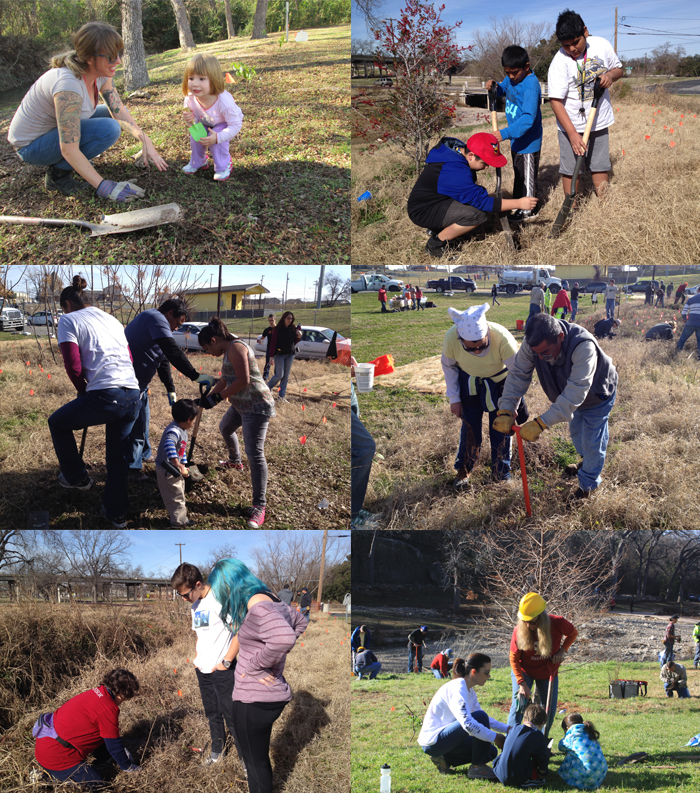Baby Trees for Grow Zones
 What happens when you stop mowing along the edge of the creek? You create a Grow Zone. Yes, once you remove the disturbance that is keeping the edge of the creek from becoming a riparian forest, it will start growing back. The first plants to exercise the right over the new place are pioneers that can withstand the degraded soils and harsh conditions created by mowing. Giant Ragweed is often the most common and vigorous one! Thanks to birds and wind bringing tree seeds to the new Grow Zone, seedlings of pioneers like Hackberry and Cedar elm will start growing. In some lucky sites, if squirrels and trees like pecans and oaks are around, you can also see baby pecans and oaks braving their way into the world.
What happens when you stop mowing along the edge of the creek? You create a Grow Zone. Yes, once you remove the disturbance that is keeping the edge of the creek from becoming a riparian forest, it will start growing back. The first plants to exercise the right over the new place are pioneers that can withstand the degraded soils and harsh conditions created by mowing. Giant Ragweed is often the most common and vigorous one! Thanks to birds and wind bringing tree seeds to the new Grow Zone, seedlings of pioneers like Hackberry and Cedar elm will start growing. In some lucky sites, if squirrels and trees like pecans and oaks are around, you can also see baby pecans and oaks braving their way into the world.
Seeing the forest for the tree seedlings

Tree Seedling
Unfortunately, urban riparian forests growing in areas that were mowed for decades tend to have a very limited set of tree species. To enhance the diversity in our Grow Zones we plant tree seedlings (which are basically live trees that look like a stick with roots).
The benefits of planting seedlings:
- Seedlings are healthier than most containerized trees because they have not spent a long time with their roots constrained and growing in circles within a container.
- Seedlings are less expensive and more available in nurseries than container trees.
- Small trees have small needs and many can survive even without installing irrigation.
Ready, Set, Plant!, our seedling planting events, happen in the late fall and winter months, when the weather is cooler. We plant between 25 to 30 different species of trees and shrubs in high densities, one tree every three feet, and water them only at the time of planting. Then, the seedlings are left to fend for themselves. On some harsh sites, only about ten percent of seedlings survive after one year, however, in some Grow Zones, we’ve seen a thirty percent survival rate. Some years are good for seedling survival, like 2015 with its wet winter and spring, but in others drought and heat or severe scouring storms can kill many. Thanks to the low cost of seedlings and the energy and enthusiasm of our volunteers and partner organizations, we can repeat the effort on a given site. Planting tree seedlings brings species of trees that would not disperse naturally to the sites because parent trees are not nearby. The riparian forests in our Grow Zones will be more diverse thanks to this effort. Many of our Grow Zones now have Carolina buckthorn, Aromatic sumac, Roughleaf dogwood, and many other desirable native species

Carolina buckthorn, Aromatic sumac, and Roughleaf dogwood planted in January 2013 in Dittmar Park Grow Zone. The seedlings are thriving after 2 years of growth!
Ready, Set, Plant! enhances diversity in our riparian forests but one of the most beautiful things about it is that it also brings together a great diversity of people wanting to help out. In our Riparian Restoration Program we partner with Tree Folks, Austin Parks Foundation, Austin Youth River Watch, Keep Austin Beautiful, the Forestry Program in the Parks and Recreation Department, and the Community Forestry Division, to organize and make these events possible. Because planting tree seedlings is relatively easy, a great diversity of volunteers can also help out.
As we help our riparian forests grow, caring for our creeks brings us together as community to make it happen.

For example, on a cold morning in early 2015, volunteers gathered at Northstar Grow Zone, where a section of Little Walnut creek has been growing since the mowing stopped in 2012. Tree Folks coordinated volunteers who were willing to spend their morning working on our Grow Zone. Northstar Grow Zone is special thanks to the Gracywoods Neighborhood Association who have adopted the creek and have worked tirelessly to help it grow.
Keep Austin Beautiful Adopt-A-Creek Just last year, 9,850 seedlings were planted in our Grow Zones.
In 2015/2016, the goal is to plant 4,600 more seedlings in 5 Grow Zones. Stay tuned for Ready, Set, Plant! volunteer opportunities this coming planting season.
